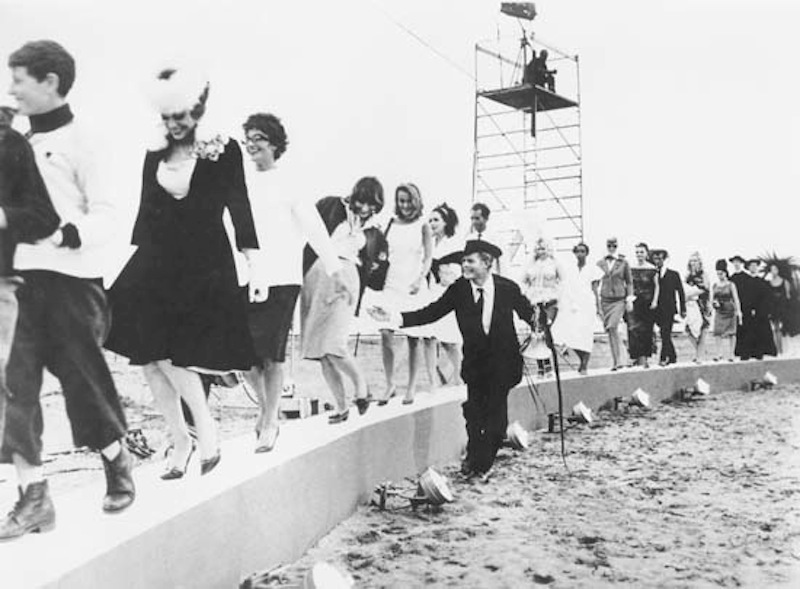Federico Fellini's 8½: Child's Play
Mary McCampbell
 Federico Fellini's epic semi-autobiographical film, 8 1/2, explores the complex interrelationship between the process of making art and the very human attempt to re-narrate and make sense of our lives. Guido, the film’s protagonist, is a director wrestling with his own limitations and the demands of his fans, critics, and producers as he experiences an artistic stalemate.
Federico Fellini's epic semi-autobiographical film, 8 1/2, explores the complex interrelationship between the process of making art and the very human attempt to re-narrate and make sense of our lives. Guido, the film’s protagonist, is a director wrestling with his own limitations and the demands of his fans, critics, and producers as he experiences an artistic stalemate.
Of course, his story was Fellini’s own story before he made 8 1/2; he had recently experienced great success with La Dolce Vita, and the artistic community was anticipating the next masterpiece. Fellini, however, was stuck. And that supposed blip in his creative stream actually became the next great masterpiece, a film about filmmaking, asking poignant questions about how an artist might make art that is both well received and truthful.
The film’s somewhat stream-of-conscious narrative is both non-linear and non-objective as it moves smoothly from present day “reality,” to Guido’s memories, to Guido’s subconscious mind. It is often hard to distinguish one from the other as both Guido’s memories (of boyhood, of his parents, of the rigid Catholic priests that shamed him, etc.) and his present relationships and projects become blurred.
Guido, the artist, seeks a sort of revelation through the making of his art; he hopes his films will both create and uncover meaning. But we become increasingly aware that a splintered, chaotic self — a mess of memories, desires, and circumstances — will struggle to present a coherent truth to his audience. How can the artist disentangle himself from the confused, knotty strands of his internal reality enough to produce something clear and true?
A critic character in the film, perhaps speaking as the voice of Guido’s super-ego, tells him: “This life is so full of confusion already, that there’s no need to add chaos to chaos.” He also argues that this messy, disruptive art — any art that is an honest reflection of Guido’s existential struggle — is not marketable because “In the end we need some hygiene, cleanliness, and disinfection.”
But the film continually reminds us that the artist is perhaps a sloppy child who has one foot in a make-believe world, the other tentatively planted on a more concrete reality. After we slip into the Guido’s childhood memories of awkward sexual awakening, mischief, and curiosity, Fellini shows us Guido as a suave, yet silly, middle-aged artist who often “plays” in order to shirk the responsibility of actually creating. But, of course, art is play. And children’s play is the act of creating.
In the film’s ending sequence, Guido embraces this spirit of messy play —and realizes that being honest about his own existential confusion is what will make true art: “Everything’s confused again, but that confusion is me; how I am, not how I’d like to be. And I’m not afraid to tell the truth now, what I don’t know, what I’m seeking.”
Guido and his team of writers, producers, actors and critics drive up to the stark, imposing outline of his half constructed failed movie set. But this realistic scene quickly morphs into something far more surreal as Fellini’s typical circus music begins to play faintly in the background and we see many figures from Guido’s life — his parents, his teachers, the women he has loved — all dressed in white, walking calmly to the beach and the scaffolding for the cancelled film. The camera pans across the bright faces of these individuals as we hear the critic’s questions in a voiceover: “And how do you benefit from stringing together the tattered pieces of your life? Your vague memories, the faces of people that you were never able to love?”
But Guido begins to ignore this criticism (the superego) and give in fully to play (the id) as he grabs a bullhorn and commands the bustling group of people from his conscious and subconscious life to make their way down the stairs. As they parade downward, the circus music wells up, and we recognize that these characters walking down the scaffolding of Guido’s now defunct film set are, in actuality, the scaffolding of Guido’s own fractured but full psyche. After this beautiful revelation, perhaps the moment of clarity that he was longing for, Guido proclaims that life is a celebration. He has the crowds of his past and present life join hands in a joyful circle as he jumps in and joins their dance.
The final moments of the film are delicate and rich as the tiny child Guido, wearing a long white cape and playing a flute, marches in the middle of the circle, followed by a few clowns playing instruments. The circle of Guido’s consciousness then disappears — and the child and his band are alone in a wandering spotlight. As the film ends, the child is completely alone, playing the flute in the spotlight, darkness fallen all around him.